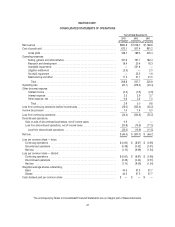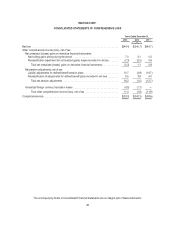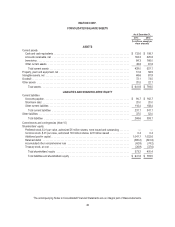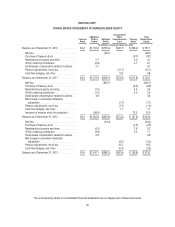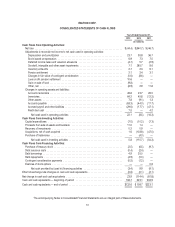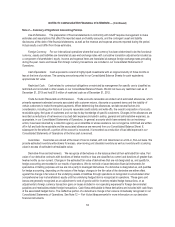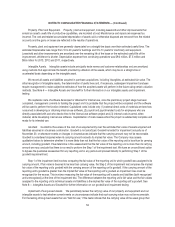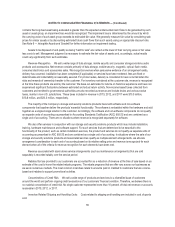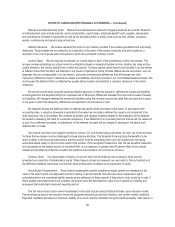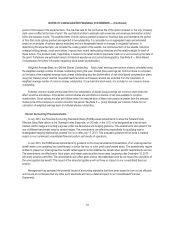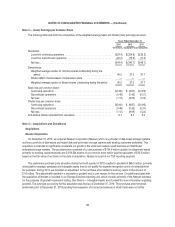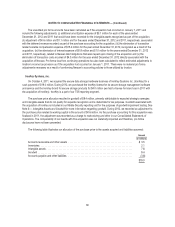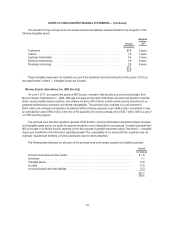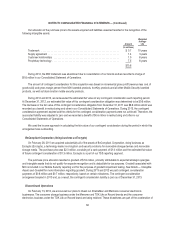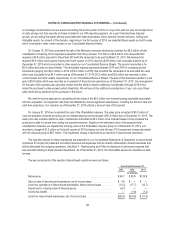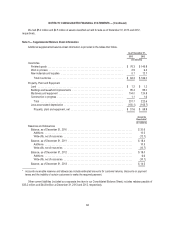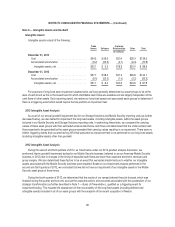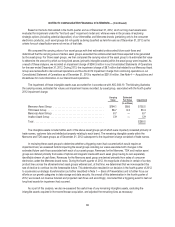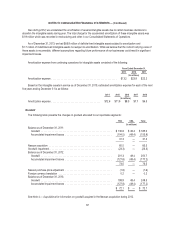Memorex 2013 Annual Report Download - page 60
Download and view the complete annual report
Please find page 60 of the 2013 Memorex annual report below. You can navigate through the pages in the report by either clicking on the pages listed below, or by using the keyword search tool below to find specific information within the annual report.NOTES TO CONSOLIDATED FINANCIAL STATEMENTS — (Continued)
period of time equal to the expected term. The risk-free rate for the contractual life of the option is based on the U.S. Treasury
yield curve in effect at the time of grant. We use historical data to estimate option exercise and employee termination activity
within the valuation model. The expected term of stock options granted is based on historical data and represents the period
of time that stock options granted are expected to be outstanding. It is calculated on an aggregated basis and estimated
based on an analysis of options already exercised and any foreseeable trends or changes in recipients’ behavior. In
determining the expected term, we consider the vesting period of the awards, the contractual term of the awards, historical
average holding periods, stock price history, impacts from recent restructuring initiatives and the relative weight for each of
these factors. The dividend yield, if applicable, is based on the latest dividend payments made on or announced by the date of
the grant. Forfeitures are estimated based on historical experience and current demographics. See Note 8 — Stock-Based
Compensation for further information regarding stock-based compensation.
Weighted Average Basic and Diluted Shares Outstanding. Basic (loss) earnings per common share is calculated using
the weighted average number of shares outstanding during the year. Diluted (loss) earnings per common share is computed
on the basis of the weighted average basic shares outstanding plus the dilutive effect of our stock-based compensation plans
using the “treasury stock” method. Unvested restricted stock and treasury shares are excluded from the calculation of
weighted average number of common shares outstanding. Once restricted stock vests, it is included in our common shares
outstanding.
Potential common shares are excluded from the computation of diluted (loss) earnings per common share when the
effect would be anti-dilutive. All potential common shares are anti-dilutive in periods of net loss available to common
shareholders. Stock options are also anti-dilutive when the exercise price of these instruments is greater than the average
market price of the Company’s common stock for the period. See Note 3 — (Loss) Earnings per Common Share for our
calculation of weighted average basic and diluted shares outstanding.
Recent Accounting Pronouncements
In July 2013, the Financial Accounting Standards Board (FASB) issued amendments to allow the Federal Funds
Effective Swap Rate (which is the Overnight Index Swap rate, or OIS rate, in the U.S.) to be designated as a benchmark
interest rate for hedge accounting purposes under the derivatives and hedging guidance. The amendments also allow for the
use of different benchmark rates for similar hedges. The amendments are effective prospectively for qualifying new or
redesignated hedging relationships entered into on or after July 17, 2013. This amended guidance did not have a material
impact on our condensed consolidated financial position and results of operations.
In July 2013, the FASB issued amendments to guidance on the financial statement presentation of an unrecognized tax
benefit when a net operating loss carryforward, a similar tax loss, or a tax credit carryforward exists. The amendments require
entities to present an unrecognized tax benefit netted against certain deferred tax assets when specific requirements are met.
The amendments are effective for fiscal years, and interim periods within those years, beginning after December 15, 2013
with early adoption permitted. The amendments only affect gross versus net presentation and do not impact the calculation of
the unrecognized tax benefit. The impact of the amended guidance will not have an impact on our consolidated financial
position.
Management has assessed the potential impact of accounting standards that have been issued but are not yet effective
and has we do not believe that any other such standards will have a material impact to our Consolidated Financial
Statements.
57


